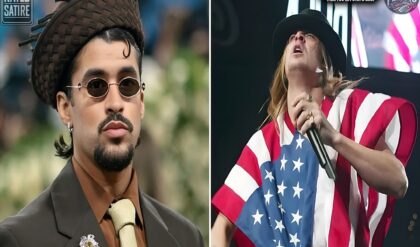John Lennon may have been the quintessential rock star — but rock’s typical womanizing meant less to him than true love. “I’m not going to sacrifice love, real love,” he told Rolling Stone in 1971…

Yoko Ono and John Lennon photographed in 1968. Susan Wood/Getty Images
John Lennon may have been the quintessential rock star — but living the lifestyle to its fullest was not his top priority. “I’m not going to sacrifice love, real love,” he told Rolling Stone in 1971 in regard to groupies, swinging and free love. “I’ve been through it all, and nothing works better than to have somebody hold you.”
It was a sea change when it came to Lennon’s attitude about women. By the 1970s, a now-solo Lennon had a failed marriage under his belt, to Cynthia Powell — as well as a history of physical violence. When conceptual artist Yoko Ono came into his life, his shortcomings were brought into stark relief, and he decided to make her his focus.

After a honeymoon year in which the pair shacked up, made art and eventually drifted from the Beatles’ orbit, Lennon and Ono wed — and Wednesday (Mar. 20) would have marked the couple’s 50th anniversary.
They met at the tail-end of the Beatles’ run, when Lennon came across an Ono installation at a London conceptual art exhibit. “I was very attracted to him,” Ono later remembered. “It was a really strange situation.” They began an affair, not letting Lennon’s celebrity (Ono claimed to have never heard of the Beatles) or his still-active marriage to Powell deter them.
The public didn’t take to Lennon’s new bride — partly due to era racism and sexism, but also a prevalent sense of being burned by the Fabs’ split and needing a scapegoat. Ono, however, was every bit Lennon’s artistic equal — and having seven years on her new husband, practically his mentor.
In art and in life, Lennon and Ono pushed each other to reach new stages of development. His minimal, introspective first solo album, John Lennon/Plastic Ono Band, used Ono’s fluxus philosophy as a lens through which to examine his deepest longings and insecurities. She took a page from his rock ‘n roll, too, cutting heady jams like “Don’t Worry Kyoko” and “We’re All Water” — with Lennon grinding away in the background.

John Lennon’s 10 Biggest Billboard Hits
It wasn’t always an unbreakable bond. In 1973, the pair separated for a spell, and Lennon ran off with their assistant, May Pang — with Ono’s blessing. They eventually mended fences. Ono gave birth to their only son, Sean Ono Lennon, in 1975, and the pair remained together until Lennon’s tragic assassination in 1980.
Every aspect of their marriage is captured somewhere in song: jolts of self-awareness (“Jealous Guy”), their dabble in drugs (“Cold Turkey”), their public-facing careers (“The Ballad of John and Yoko,” “Mrs. Lennon”) their 18-month split (“I Want My Love to Rest Tonight”), Sean’s birth (“Beautiful Boy”) and their reconciliation (“Starting Over”).
Here’s a timeline of the Lennons’ marriage — along with the songs that soundtracked each period in their history.
Lennon and Ono Ignite Affair While Lennon’s Wife is on Holiday
Listen to: John Lennon and Yoko Ono, Two Virgins (1968)
Two versions of Lennon and Ono’s meeting story are out there. The first, which the couple told interviewers, is that they met at a conceptual art exhibit called Unfinished Paintings and Objects.
Lennon, unimpressed by pieces that consisted of a single apple or a bag of nails, was captivated by Ono’s: a stepladder leading to a magnifying glass held up to the printed word “Yes.” (“It’s a great relief when it doesn’t say ‘no’ or ‘fuck you’ or something,” said Lennon.)
The second, as told by Paul McCartney, was that Ono was seeking song manuscripts for a book project she was working on with minimalist composer John Cage — and that Lennon offered up the Rubber Soul deep cut “The Word.”

John Lennon and Yoko Ono ‘Wedding Album’ Reissue Announced
Whatever the case, it was the beginning of a sizzling romance. In a now-famous anecdote, Lennon invited Ono over to play with tape machine noise, culminating in the pair “making love at dawn.” Cynthia came home to find the pair in matching white robes. The couple divorced in 1968.
The result of the tape machine experiments was Two Virgins, a long, eerie sound collage featuring Lennon and Ono naked on the cover sleeve. EMI refused to distribute it; it was released to stores in a brown paper bag.
The Couple Writes Polemics as the Beatles Implode
Listen to: The Beatles, “The Ballad of John and Yoko” (1969) John Lennon, “Give Peace a Chance” (1969)
Lennon and Ono didn’t marry quietly, but noisily. After their nuptials in Gibraltar, they staged a series of honeymoon stunts for the press, including their famous Bed-In campaign for peace at the Hilton Amsterdam.
Afterward, they moved the Bed-In to Montreal, where they invited a gaggle of press and checkered characters like Timothy Leary, Allen Ginsberg and Murray the K to join the party. With the whole motley crew hollering along, they recorded the classic anti-war anthem “Give Peace a Chance” right there in the hotel room.
Still not satisfied with his public bonanza, Lennon asked McCartney to join him in the studio to record a pissy tirade: “The Ballad of John and Yoko.” It’s full of quotable moments, from taking the Lord’s name in vain to a now-dated insinuation that Gibraltar is near Spain.
“Yoko and Me — That’s Reality”
Listen to: Plastic Ono Band, “John John (Let’s Hope for Peace)” (1969), John Lennon and Yoko Ono, “Who Has Seen the Wind?” (1969), John Lennon, “God” (1970)
As Lennon mulled over finally quitting The Beatles, he impulsively took an offer to perform at the Toronto Rock and Roll Revival festival — with no band. He grabbed Ono, Fabs compatriots Eric Clapton and Klaus Voormann, and Alan White, the drummer for a bar band that Lennon recently enjoyed called Griffin. There was no rehearsal, save for on the plane. Lennon dubbed them the Plastic Ono Band.
The group showed up during Little Richard’s set and ran through a sloppy set of oldies and Beatles covers — later released as Live Peace in Toronto 1969. It ended with a spectral cry of devotion from Ono: “John John (Let’s Hope For Peace)”. A similar vibe popped up on The Wedding Album, in a faux-medieval love song by Ono called “Who Has Seen the Wind?”.
Soon after, Lennon ended his first solo album, John Lennon/Plastic Ono Band with “God,” an evisceration of idols Lennon deemed false. He was burying the lede. “I just believe in me / Yoko and me,” he sings near the end. “And that’s reality.” It would be so for the rest of his life.
Lennon and Ono Join Forces and Come Into Their Own
Listen to: Yoko Ono, “Mrs. Lennon” (1971), John Lennon, “Oh My Love,” “Oh Yoko!” (1971)
Come 1971, Lennon released Imagine, his commercial solo breakthrough — and one heavily influenced by Ono. She was awarded a songwriting credit for the title track in 2017. Elsewhere on the album is the vulnerable devotional to Ono, “Oh My Love,” and the exultant “Oh Yoko!”, in which he calls his bride’s name to a bouncy shuffle beat by White.
RELATED

Yoko Ono Announces Upcoming Album, Releases New Track ‘Warzone’: Listen
That year, Ono also released “Mrs. Lennon,” in which she clapped back at the patronizing public who still viewed her as a rock star’s “Japanese broad” — Lennon’s words. If “Mrs. Lennon” is a distressing view into the way she was treated by chauvinistic journalists, Ono’s thrown shade won out.
The Lost Weekend
Listen to: Yoko Ono, “Song for John,” “I Want My Love to Rest Tonight” (1973), John Lennon, “Aisumasen (I’m Sorry)” (1973)
The couple hit the rocks in 1973, just as they moved into the Dakota Apartments. “We were ruining each other’s careers and I was hated and John was hated because of me,” Ono later told The Telegraph. It left Lennon restless and behaving poorly.
His jealous behavior flared up. He cheated while intoxicated with a girl at a party in which Ono was present, yet became so possessive that he wouldn’t let Ono visit the bathroom alone.
Ono needed a break — and came up with a strategy to get it. She allowed Lennon to abscond with their personal assistant, May Pang. Ono’s songs “I Want My Love to Rest Tonight” and “Song for John” soundtrack late-night what-ifs while she held court at the Dakota.
Lennon felt similarly. In “Aisumasen (I’m Sorry)”, a repentant ballad from his 1973 album Mind Games, he begged for forgiveness in Ono’s native Japanese.
Starting Over
Listen to: Yoko Ono, “Hard Times are Over,” “Every Man Has a Woman Who Loves Him” (1980) John Lennon, “(Just Like) Starting Over”, “I’m Losing You,” “Dear Yoko,” “Woman” (1980)
Ono’s strategy worked. In 1975, she and Lennon reunited — and in a happy shift from a series of lost pregnancies, they welcomed their son Sean Taro Ono Lennon. Where Lennon was often absent or dismissive to his first son, Julian, Sean was the light of his life. For five years, he all but disappeared from music to raise him.
RELATED

John Lennon, Yoko Ono Film In the Works With Jean-Marc Vallee Directing
Those years in the Dakota are marked by domestic bliss: bread-baking, cat-rearing, looking after Sean. Eventually, in 1980, the couple released Double Fantasy, full of odes to newfound contentment: “Dear Yoko,” “Hard Times are Over,” “Beautiful Boy (Darling Boy)”. They seemed to have sloughed off the chaos.
One night in 1980, following the couple recording the song “Walking on Thin Ice,” Lennon opted to say goodnight to Sean rather than go out to dinner at the Stage Deli restaurant. As Lennon and Ono exited their limousine, a mentally ill fan shot and killed him in front of the Dakota.
Remember
Listen to: Yoko Ono — “I Don’t Know Why,” “No, No, No” (1981), “Imagine” (2018)
If Double Fantasy reminded the world that Lennon was a husband and doting dad like any other, Ono’s solo album Season of Glass was a heartbreaking grief statement. “I Don’t Know Why” and “No No No” aren’t tributes to a legend, but a husband and father.
In a touching epilogue to Philip Norman’s John Lennon: The Life, an adult Sean offered tangible memories of his father. “I remember his face, his neck, his hair, his calves and that bump on the right side of your ankle,” he said. “I remember the feel of the stubble on his chin very clearly.”
He and Ono have carried Lennon’s essence ever since. In 2017, Ono was surprisingly awarded co-authorship of “Imagine,” a song she facilitated with her book Grapefruit. On her subsequent album Warzone, she finally covered it herself — in a faltering, moving warble.





